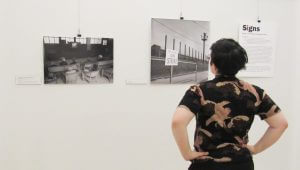How the REcollection Studio transformed an archive in to an art exhibition, by Rebecca Stewart
For the Winter and Spring of 2018, I had the great opportunity to work alongside the Carnegie Library of Pittsburgh’s REcollection Studio to create an exhibition using the Pittsburgh Photographic Library (PPL). The PPL was originally conceived in 1950 as an initiative by the Allegheny Conference on Community Development to document the city’s urban renaissance.


Unfortunately, the studio had a rocky lifespan and inevitably shut down in 1954. During its time, however, it took nearly 15,000 photographs – approximately 11,000 still exist within the Carnegie Library’s collection. The medium and large format negatives and 12 dozen albums of small black and white photos are currently unavailable to the public, though the REcollection Studio hopes to change that and is currently working on digitizing the entire collection for public viewing.


What does creating an exhibition from the ground up entail? Specifically, an exhibition centered around a collection of over 11,000 photographs with very little available provenance? One professor who taught seminars on exhibition creation emphasized that the first step (and the foundation for all following steps) is the development of a “Big Idea.” Think of the “Big Idea” as the thesis statement of the exhibition; it summarizes the theme and the intent of all the content.
In an ideal situation, I would have looked at the PPL and known immediately what needed to be said and shown. In reality, I flipped through the photo albums three times before I stopped on the one particularly striking photo which set my brain in motion. Pictured below is a boy, or as the caption in the album says, a “child(ren) of the Hill District.” He’s wearing a handmade mask (made from what appears to be a cinema flyer) as he looks into the camera and smiles. My first thought was, “This unnamed kid is seen and unseen.” The mask and lack of name reminded me of all the unheard voices in the Hill during the 50’s during its unbidden transformation.
If I’m being honest, I was looking for commentary because I knew that this time had been a difficult one for many communities and there was a lot to be said about the subject. This boy, as I saw him, was a signal of that moment in history and on his face was a very literal sign.

From then on, it was all about the transition from archive to exhibition. After selecting the photographs, I scanned the negatives to prepare them for printing. Keep in mind, these photographs only exist in negative form, so this would be their first transition into a modern format. The REcollection Studio has the technology needed to complete this task and maintain the beautiful detail and depth of the photographs.
Next came creating the wall text that would allow the viewers to understand the intent behind the exhibition. A curator needs to think about every little detail, down to fonts and margins and format. With all these tasks completed, we installed the exhibition in to the Gallery @ Main. In addition to the month-long presence in the gallery, I also created a reading list and gave four tours in order to talk to patrons one-on-one regarding the collection.


The leap from archive to exhibition is an interesting one. The curator has the opportunity to create a snapshot of what the collection has to offer. Exhibitions based on archival collections are a crucial method of engaging with the public and bringing the resources of the past into the future in a creative way.
The Pittsburgh Photographic Library is a fantastic resource that shows the multidimensional landscape of Pittsburgh during the early 1950s. “SIGNS” is just one perspective on this collection, and through the hard-work of the REcollection Studio, everyone will get the chance to see it through their own lens.
Didn’t make it to the library?
You can always take a virtual tour of the SIGNS exhibition!Rebecca is a graduating University of Pittsburgh Anthropology and Museum Studies major currently interning with the Carnegie Library’s REcollection Studio. As an intern with the REcollection Studio they’ve curated “Signs,” an exhibition on the library’s Pittsburgh Photographic Library collection.


